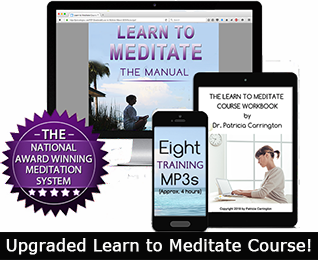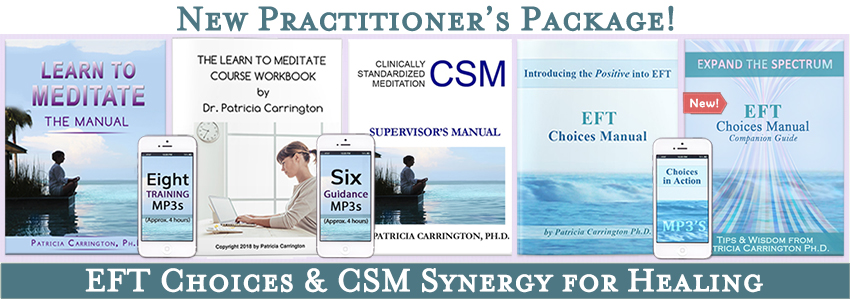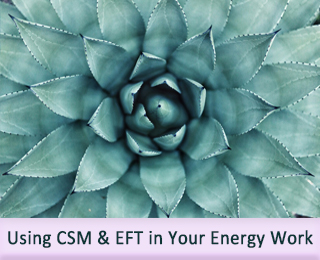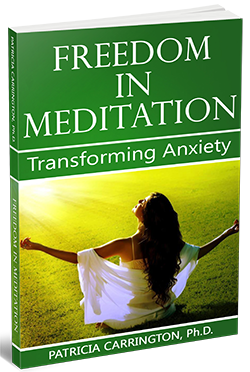Dr. Patricia Carrington discusses problems, such as whether you should close your eyes during meditation and tension release side-effects frequently encountered by new meditators, along with some advice regarding them.
Play Audio (Duration: 9 minutes 1 second)
Listen right now, or download for later. (To download, right click or control click the link)
Problems Encountered with Meditation
This audio clip is excerpted from Dr. Patricia Carrington’s Learn to Meditate Course
Now, I’d like you to go over in your mind some of the good feelings that you may have had during these first few meditations, or some responses you may have noticed following meditation, or in between meditations, some effects that you think may possibly be related to meditation. Just think about these things.
And now I’d like you to think about any possible problems or questions that you had about your meditation experience. You may not have had any problems, but if you did, lime these up in your mind.
To help you understand the process better, I’m going to mention a few problems that are quite frequently reported on the second day of meditation by people, like yourself, who just learned.
Some people report that they don’t know whether or not they were sleeping during meditation. They say they seem to feel both awake and asleep at the same time. Actually, it’s quite possible to drop into sleep, momentarily, just for a few seconds or so at a time, and then to wake up almost immediately, again. But, these mini sleeps make no difference, whatsoever, in the effectiveness of the technique.
My advice is not to waste your time trying to figure out whether you’ve been awake or asleep at any particular point. But, simply to accept the meditative experience as it comes. I’ve already mentioned the tension release side effects, or momentary discomforts, occur to some meditators, particularly at first, when they’re releasing large amounts of accumulated tension.
It’s not usual that a side effect will persist to the end of the meditation session and continue after meditation. They almost always dissolve in the quietness of the state. But, once in a great while somebody reports that a side effect didn’t go away by the end of the meditation.
If this should ever happen to you, there’s something very simple you can do about it, and it’s extremely effective. Let me give you an example. Suppose you had a momentary discomfort in, say, your hand. And, the discomfort didn’t go away by the end of the session. The thing to do, then, is to close your eyes again and continue meditating, but, this time, don’t meditate on your mantra, alone, although, the mantra can go on in the background, if you wish. You meditate on the discomfort itself, as though it were the mantra. By that I mean, turn your attention, lightly, to the source of discomfort.
In this case, it would be to your hand, and just flow with the discomfort. Don’t try to fight it. Don’t try to make it go away. Go with it. And, it’s amazing to find how the discomfort, whatever it is, will tend to dissolve and disappear with this kind of attention.
Actually, we make things strong; we solidify them, by fighting them. When we flow with a discomfort, or a momentary irritation, then it loses its strength.
One thing you should realize is that it takes time to get the feel of meditation. It takes practice, and some people make themselves uncomfortable, at first, because they’re trying too hard.
If, at any point, you’ve been making an effort to remember your mantra, or to keep saying it, you’re defeating the purpose of meditation. The mantra should never be work. You don’t force It. You don’t make yourself go back to it. You just allow it to come back to you. And, you don’t really say the mantra in your mind, you let yourself hear it. There’s a difference.
I often tell people that it’s as though the mantra were always there, like a radio signal is there before you tune into it. And, at certain times, you simply choose to mentally turn up the volume, so to speak, so you can hear it.
In other words, meditation is a vacation from effort. It’s a natural process, so don’t make the mistake of thinking that you’re not meditating correctly, because it’s often so easy.
Sometimes, I think we feel that something that doesn’t require a lot of work on our part isn’t worthwhile, and we couldn’t possibly be doing it correctly. With meditation, this is not the case. Its easiness is what makes this form of meditation so beneficial.
Now, another problem that’s occasionally reported is that a meditator will say that they feel very restless sitting still and that it’s truly hard for them to remain in one place. These are very apt to be people who are extraordinarily active in their everyday lives; the kind of person who just doesn’t sit still a moment. They’re always bustling around finding something to do, keeping busy.
I find it very useful for such people to move slightly during meditation. For example, a person experiencing this particular problem can rock a little bit. Perhaps, even use a rocking chair to meditate in. This is very soothing and it takes just enough energy so that the need to expend energy is continuous. The rocking can be in rhythm with the mantra. Or, the person might want, instead, to nod their head slightly, in rhythm with the mantra. Or, the tap their foot gently, or just clasp and unclasp their hand, very lightly and repeatedly, in time with the mantra. Or, they can make some other small motion that doesn’t require too much energy.
When they do this, they may find that as the meditation goes on and they becoming very deeply relaxed that their motions may get slower and slower. Perhaps, they’ll even stopped all together. And, they should allow them to do this. I find this is often a very successful solution for the active person who doesn’t find it comfortable to sit quietly.
Now another problem that’s occasionally reported is when a meditator finds it difficult to keep their eyes closed during meditation. Often, these will be very visual people, artists or architects; somebody who uses their eyes a great deal in their work.
If you have a strong resistance to keeping your eyes closed, you should realize that there’s no law that says you have to keep your eyes closed during meditation. There are some very respectable forms of meditation, for example, Zen meditation is used in the monasteries, where the meditator keeps their eyes partially open, and gazes at a spot about three feet in front of them for the entire time.
So, if you’re having this difficulty, by all means open your eyes intermittently, or keep them open continuously, during the meditation and just keep thinking the mantra at the same time.
In this case, it’s a good idea to have something pleasant to rest your eyes on, something that won’t be distracting, say a green plant or simple vase or some other natural object.
There were a few other problems that are occasionally reported by meditators, but so rarely that I’m not going to take time here on the recording to discuss them. Instead, I’ve listed some of them in a section in your booklet called Special Problems.
If you happen to experience some difficulty that I haven’t mentioned here, look in that section of your booklet and see if it takes it up. I wouldn’t, however, advise you to read that section, if you’re not having any such problems, because it might confuse you. At this point, if you want to read about the various difficulties that other people occasionally experience, that’s fine, but it’s better to wait until your own meditation is well-established and until you solve your own problems first.
 This easy-to-follow instruction kit contains downloads of the 8 audios, plus the Learn to Meditate Manual (PDF) and the Interactive PDF Workbook. Using this method you can master meditation within a week and feel its powerful effects at once. See complete details…
This easy-to-follow instruction kit contains downloads of the 8 audios, plus the Learn to Meditate Manual (PDF) and the Interactive PDF Workbook. Using this method you can master meditation within a week and feel its powerful effects at once. See complete details…






